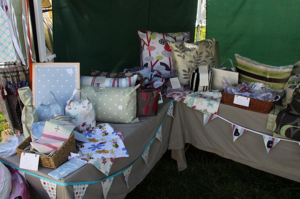Selling at craft fairs

Craft fairs can be an excellent way to sell your home created items and homegrown produce. They can be attended regularly or periodically, while some craft fairs are held only at special times of the year for seasonal or holiday events. If you find it profitable to sell a craft fairs, it may even be worth developing a a travelling circuit to capture a wider range of fairs.
Ideas of what to sell[edit | edit source]
By way of homegrown produce: You can add value to foods grown by turning them into jams and jellies, flavoured vinegars and syrups, pickles and sauces, and so forth. For the more advanced practitioner, you could make cheeses, olives in brine, smoked meats, and the like.
By way of homemade produce: You can make lots of items using sewing, embroidery, woodwork, metal smithing, paper, repurposing, and so forth.
Choosing fairs[edit | edit source]
You can choose local, regional or national fairs. Each has benefits and drawbacks.
- Local fairs: You are known or supported by locals, easier to get to (spending less on fuel and travel), might be easier to restock quickly, etc. On the downside, the customer base might be smaller or diminish with frequency of visits, your wares might not get the coverage you'd desire, etc.
- Regional or national fairs: Larger customer base, new customers, more chances to sell crafts and produce further afield, could be included in regular monthly or annual rounds to different parts of the country, etc. Downsides could include travel and fuel costs, higher site/stall fees possibly, needing to take more stock with you when travelling, etc.
- Seasonal or holiday fairs: Usually only held at specific times of the year but may be worth putting all of your effort into as they can often return higher amounts for the one occasion. For example, a Christmas craft fair or a summer holiday fair.
Getting started[edit | edit source]
Find out about the fair first. Many fairs now have websites with detailed information on what costs are involved for spaces, the types of goods required and the level of quality expected.
Be aware that some fairs are so popular that there are waiting lists to get a place/stall/position. You may need to juggle some casual spots for a time until a vacancy arises or the managers of the fair realize the worth of your stall.
Setting up[edit | edit source]
- Table, trestle
- Portable tent/marquee or cover of some sort for wind/rain/sun protection
- Signage and pricing
- Covering for table/trestle
- Hanging space and hangers/pins, etc.
Other considerations:
- Safety and health (includes food safety if you are selling food crafts; be sure to meet the relevant regulations for your area)
- Weather damage (wind, rain, hail, etc.; even a gusty breeze can cause damage if unprepared)
- Theft and accidents (stock loss)
Beyond the fair[edit | edit source]
Consider having an online presence of some sort, such as a Facebook page, a website or some other means of seeing your wares and contacting you. Many people have an expectation of such availability online now, so even if you're not keen on it, get a family member who is competent with this to help out!
Online presence can be really helpful where a customer would like you to customize wares, such as showing them different colours, patterns, fabrics, styles, sizes, etc. of prior projects or current materials. This can speed up exchanges by email or text to finalise a commissioned item.